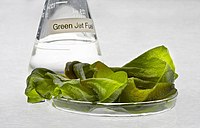
Photo from wikipedia
The sugar industries and ethanol distilleries have been rapidly expanding globally since bioethanol emerged as a renewable bioenergy source. However, these industries generate large volumes of wastewater with high levels… Click to show full abstract
The sugar industries and ethanol distilleries have been rapidly expanding globally since bioethanol emerged as a renewable bioenergy source. However, these industries generate large volumes of wastewater with high levels of organic matter, nutrients, and metal contents, which are discharged into the nearby environment without adequate treatment. This industrial pollution may have an adverse effect on aquatic and terrestrial ecosystems. Hence, this study aimed at investigating the physicochemical properties and metal constituents of sugar industry and ethanol distillery wastewater and its adverse effect on the environment. The study also assessed the legal framework of industrial wastewater management in the sugar–ethanol industry. The wastewater samples were collected from Metahara sugar factory and ethanol distillery using time-composite sampling techniques. The laboratory analyses of physicochemical parameters and metal constituents of the wastewater were performed using standard methods. Results show that the physicochemical properties of the sugar industry’s wastewater (mg/L) were pH 7.6 ± 0.5, total solids (TS): 3050 ± 628, 5 days biochemical oxygen demand (BOD5): 1052 ± 560, chemical oxygen demand (COD): 1752 ± 433.0, NO3− N: 0.4 ± 0.3, PO4−3: 3.5 ± 1.5, SO4−2: 30 ± 9.0 and Cl−: 45 ± 10.4, whereas the ethanol distillery parameters (mg/L) were pH 3.9 ± 0.1, TS: 150,300 ± 9200, BOD5: 40,271 ± 3014, COD: 132,445 ± 6655, NO3− N: 3.2 ± 1.0, PO4−3: 21.2 ± 2.7, SO4−2: 4502 ± 69 and Cl−: 6722 ± 873. The metal constituents of the sugar industry and ethanol distillery wastewater were, respectively: Na: 61.1–113.4, 207.6–263.0 mg/L; K: 87–161, 1143.9–2987.0 mg/L; Mg: 274.2–341.0, 816.3–927.6 mg/L; Ca: 376.9–468, 1787.4–3389.8 mg/L; Cr: 0.01–0.06, 0.8–2.3 mg/L; Cu: 0.2–0.7, 1.1–1.5 mg/L; Zn: 1.3–3.5, 1.4–2.8 mg/L; Fe: 3.2–4.3, 13.8–19.6 mg/L; Ni: not detected, 0.13–2.7 mg/L and Mn: 1–1.5, 1.5–6.6 mg/L. All except one bivariate correlation between concentrations of the metals were strong (r > 0.5). The BOD5/COD (biodegradability index) of the sugar industry was 0.60, whereas the ethanol distillery was 0.25. Analysis of variance showed the concentrations of metals in the two industries were statistically significant (p < 0.05). Most of the parameters in this study were beyond the maximum permissible discharging limits, possibly interfering with physicochemical and biological processes in the natural environment. Hence, for the benefits of the environmental safeguards and sustainable water use of the sector, we recommend that the two wastewaters be treated using integrated approaches through blending using the biological method.
Journal Title: Sugar Tech
Year Published: 2019
Link to full text (if available)
Share on Social Media: Sign Up to like & get
recommendations!